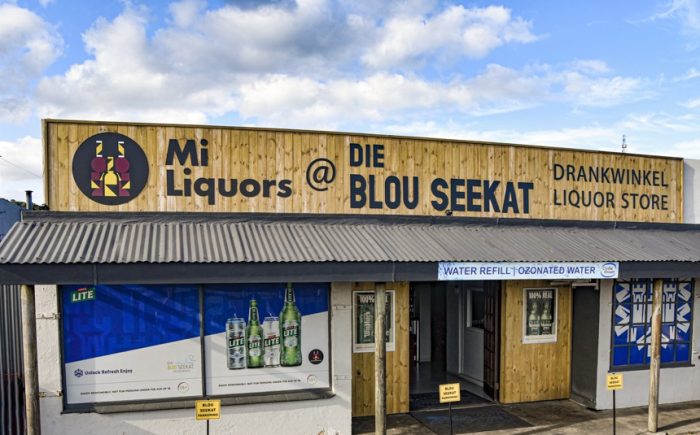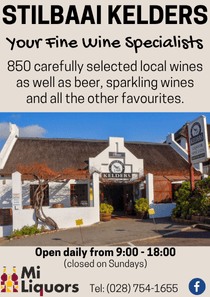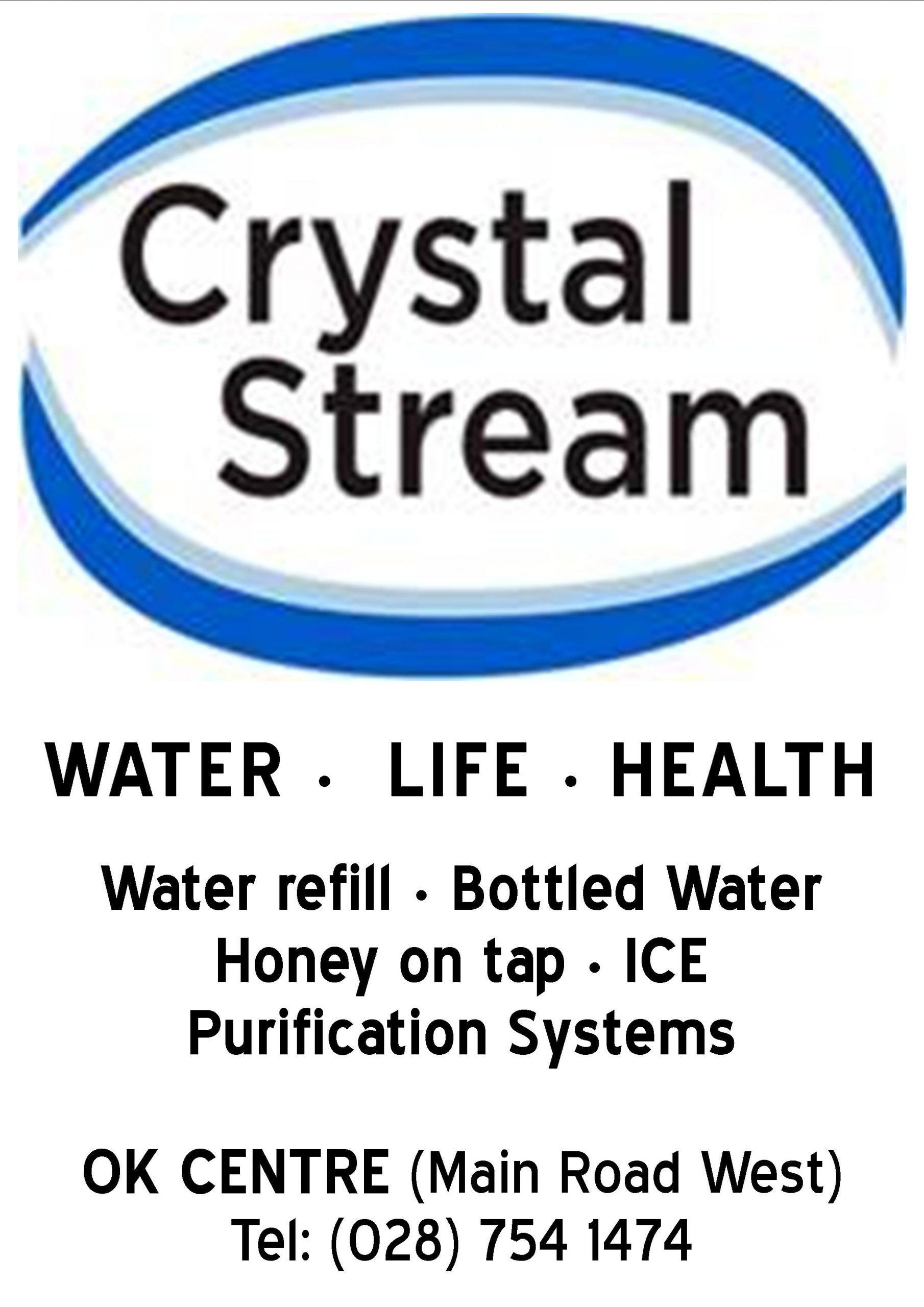by Elza | Nov 16, 2017 | Uncategorized
‘Die Blou Seekat’ het vastrapplek in Stilbaai-Oos gevind.
Dié enigste aan die oostekant van Stilbaai, is perfek geleë langs die kafee in Hoofweg-Oos by die eerste stopstraat en is in die hande van Adolf Botes en Johannie Vermeulen wat bekend geword het vir hul groot verskeidenheid uitgesoekte wyne en netjiese winkels, Stilbaai Kelders, in Voortrekkerstraat in Stilbaai-Wes en Oppie Hoek (op die hoek van Hoofweg-wes en Buitekantstraat).
“Ons wil deur middel van Die Blou Seekat-drankwinkel aan kliënte in Stilbaai-Oos dieselfde diens lewer as wat ons by Stilbaai Kelders doen alhoewel ons vanweë die beperkte ruimte ongelukkig nie dieselfde hoeveelheid voorraad, en veral wyn, daar kan aanhou nie,” sê Botes.
Kopers is egter altyd aangenaam verras deur die hoeveelheid en verskeidenheid produkte in die nuwe winkel en die Mi Liquors Blou Seekat is altyd gereed vir die vakansiebesoekers. Kliënte wat uit meer as 850 wyne wil kan kies en sommer verdere aankope doen terwyl hulle in die weste is, kan Stilbaai Kelders besoek terwyl diégene wat nié oor die brug gaan nie, wel die ander gewilde produkte by Die Blou Seekat sal kry.

Ys is ook hier beskikbaar asook gesuiwerde water wat hiér getap kan word.
‘Mi Liquors Die Blou Seekat’ is daagliks (behalwe Sondae) oop van 9:00 tot 18:00 en tot 20:00 gedurende Desember-vakansies.
Besoek gerus hul Facebook-bladsye – Die Blou Seekat Drankwinkel en Stilbaai Kelders – vir meer inligting.
Einde
by Elza | Oct 17, 2017 | Uncategorized
About a year ago, 33 members of the Cape Bird Club visited Stilbaai for a three day camp and their bird watching adventure started at Botterkloof Resort situated about 5 kilometres outside Stilbaai next to the R305 that leads to the N2. They chose the self-catering option at this resort with its ponds and large trees and saw a Greater Honeyguide as well as an Olive Woodpecker, weavers and bishops, a host of wagtails, a Common Moorhen and even a Malachite Kingfisher as well as a Knysna Woodpecker before their camp started in all earnest.
In their report posted on their website www.capebirdclub.org.za the group describes where their convoy of nine vehicles drove and which birds they spotted. On the first day, their list included Brimstone, Cape, White throated and Yellow canaries, Brown-hooded, Giant and Pied Kingfishers, an African Spoonbill, Large-billed and Red-capped Larks, Olive Bush Shrike, Streaky-headed Seedeater, a Bar-throated Apalis and a Booted Eagle as well as an African Fish Eagle amongst many. They were however disappointed that the Black Cuckoo that was spotted just a week earlier, failed to appear.
It was quite windy when they got to the coast and they had no luck in seeing a Shy Albatross. They did manage to see a White-Chinned Petrel, oystercatchers, cormorants, terns and gulls and a Grey Plover and on their way back to their camp, they spotted a lone whimbrel and a common sandpiper.
On the second day they were off early again and in search for the Clapper Lark and they made several attempts to connect with it. At least a Denham’s Bustard show itself – they are apparently often seen too far from the road to notice all the markings – and it was ticked off. The group was really desperate for the sighting of the Clapper Lark and tried again to connect with it. In the meantime they saw a Zitting Cisticola as well as a Cape Robin Chat, Karoo Scrub Robins, Karoo Prinia, a Jacal Buzzard and Cape Bulbuls. They were surprised about the minimum amount of Larks and pipits on the ground, but saw an African Pipit. A Southern Black Korhaan was heard, but not seen…
At a bridge over the Gouritz River, they saw Saw-wings and swallows, some Horus swift, Pied Starlings and a Pied Kingfisher. They went back to the coast in their search for the Shy Albatros, but had no luck again, despite the presence of a trawler and had to settle for an Osprey that flew in and out of the waves. Looking at their list, they were pleased to have seen 146 birds in total.
Some members headed back the next day while others took on one of the shorter coastal hiking trails before visiting the museum at the Palinggat Homestead and watching the tame freshwater eels being fed. This group was lucky enough to have heard the call and then saw the elusive Knysna Warbler near the start of the trail that leads down to the river mouth.
Read about their bird watching experience on www.capebirdclub.org.za
Knysna Woodpecker
The Knysna woodpecker is endemic to South Africa, being found in woodlands and thickets along the southern coastline. It mainly forages in trees, searching dead branches for invertebrates and gleaning ants from branch and leaves. Both sexes excavate the nest, which is usually a hole in the underside of a branch, often reused over multiple breeding seasons. Here it lays 2-4 eggs, which are incubated for roughly 21-13 days (estimated). The chicks are fed by both parents, and stay in the nest for an estimated 25-27 days. (www.biodiversityexplorer.org)
Where to do birding in Stilbaai
Almost anywhere! There is also a bird hide just off the gravel road on the way to the Skulpiesbaai parking area; visit places like Botterkloof Resort (have a look at the list of birds spotted here) and Palinggat Homestead (Stilbaai Tourism and Information Centre where the freshwater eels are being fed daily).
End

The Knysna Woodpecker (Photo Per Holmen – www.pers-birding-pages.com)
by Elza | Aug 26, 2017 | Uncategorized
Recently, while angling at Blombos, local Stilbaai angler, Graeme Forrer and his angling friends came upon an African penguin (Spheniscus demersus) that had fallen into an ecological trap and was too weak to continue. Forrer, together with Vlooi Botha, Bernard Forrer and Cleo Rowe took it home, nursed it, bathed and fed it and walked penguin ‘Winston Churchill’ until they could safely deliver him to SANCCOB (Southern African Foundation for the Conservation of Coastal Birds).
Graeme Forrer – @yo_fishy on Instagram – tells how astounding it was to watch Ozzy, the King Charles Cavalier with his loving nature, as he expressed his concern and even managed to lick the penguin clean without having his tongue pierced! Said Graeme: “Penguins are certainly not pets and should always be handed to professional care as soon as possible,” – which they did. Marna Smit, Sanccob bird rehabilitator, said to the Cape Argus that although the organisation do not advise keeping a wild animal, the penguin was ina better state when it arrived there than when the anglers took it in.
“When you find a bird you must bring it in immediately. If it doesn’t run away from you or try to get back into the ocean, that means there is a problem and the bird needs help. In this case the bird was dehydrated, weak and could barely walk.” – Cape Argus. The penguin was taken to the vet and is currently in recovery.
Graeme Forrer, a catch and release angler who recently also competed in the 25th Stilbaai Galjoen Derby where his team scored bronze medals from 71 participating teams (432 anglers), dedicated his Instagram post about the ‘once in a lifetime experience’ to “the good souls who love fishing and make a positive impact on our beaches and the surrounding environment.”
End
by Elza | Aug 24, 2017 | Uncategorized
Stilbaai is not only a popular holiday destination, but it is also well-known among surfers as a surfing destination and advanced surfers prefer to tackle the waves especially at Morris Point. Here dolphins and even seals have joined surfers in the action.
Less experienced surfers prefer the softer breakers at Lappiesbaai while those with even more experience are regulars at the rough coast of Jongensfontein.
Here are the various surfing spots in Stilbaai and Jongensfontein according to www.wavescape.co.za, a South African surf forecasting and coastal lifestyle website that has been in existence since 1998. They also provide marine forecasts to the surf industry and the public and run the Wavescapes Surf Film Festival which screens the world’s best surfing and ocean conservation films.
Stilbaai – a grinding right-hand point break with a classic mid-break section, and sometimes a deep, thick outside section for the stout of heart. When big, a strong rip pushes you down the rocks. Like many points along the east coast, Stilbaai likes a lined-up south to southeast swell. A huge west or southwest swell bends around the outside point and reforms a lot smaller on the inside, with much of its energy broken up. As the swell angle moves to southeast, the swell comes in straighter, avoiding the outside reform. Best in glassy seas or light westerlies on a pushing mid tide in clean four- to eight-foot swell.
Dolfines Point – A gnarly, ledging right-hand point reef with some seriously hollow sections deep in wild fynbos. Needs a solid 10-foot-plus south swell before the swell wraps into the bay, or southeast swell of course. Needs light northwest to northeast wind. Only good surfers need apply.
Skulpiesbaai – In the middle of the bay across from Dolfines Point lies a small triangular reef with good right-handers in clean groundswell and light winds. On the eastern side of the bay, which is in effect the reverse side of Stilbaai Point, some good lefts break off the rocks. Best when a powerful five- to eight-foot southeast swell is running.
Jongensfontein – When you’re headed to Stilbaai in the mistaken belief that it will be firing, Jongens might appease you. Jongens prefers a two- to five-foot southwest to south swell, and breaks off a reef running right. The northwest to west wind is offshore, but it needs to be light.
Kakgat (Jongensfontein) – Triangular-shaped reef with right-handers peeling off the top of the reef, sometimes running up to a shore-break close-out. Prefers light west to northwest wind and clean three- to five-foot groundswell. Careful when pulling off the floater at the end. You might get a sand enema you won’t forget. On the scatological theme, Kakgat was named in the 1980s when former Springbok rugby player Rob Louw took a dump into an underground municipal sewage tank at the break.

Surfing action at ‘Kakgat’, Jongensfontein (2016)
Ramyatoolies – A fast, powerful left-hander off some rocks further down the beach. It was first surfed in 1984 but the locals did not have a name for it. Then someone told a derogatory joke – which we decided not to publish. Please visit www.wavescape.co.za for the story… – but the name Ramyatoolies or ‘Toolies’ stuck.
According to www.wannasurf.com the normal length of the waves at Morris Point is 50 to 150 metres and on a good day, the length is 150m to 300 metres. The swell size starts working at 1.0m to 1.5m / 3ft to 5ft and holds up to 4m+ / 12ft. The best tide position is mid and high tide.
Says popular surfer and model, Roxy Louw, who enjoys holidays in Stilbaai with the family: “Whenever I paddle out in Stilbaai, I take a step into my childhood. I still get butterflies and a warm feeling out there. It’s one place I truly feel safe. One having surfed it for years and secondly that I have dived the whole reef and collected “allekrik” and fished the rocks as a child. I know every rip-tide, but it also holds close to my heart as my dad was one of the first guys to surf Stilbaai and named “Kakgat” after a boys trip. My ‘oupa’ Matt who recently passed at 94, was a fond body surfer and his ashes will be thrown into the surf following his wishes. He always called Stilbaai ‘heaven’ and us youngsters have come to have a slice of it too. I will forever spend endless surfs and also teach yoga over the holiday season there at the local health studio.”
Sufer and Kfm surf reporter, Deon Bing, about surfing in Stilbaai: “You’re a little surfer out there in a big ocean…”
The 18th Vintners Surf Classic took place at Stilbaai’s Point earlier in August and despite the wet weather, it was enjoyed by all the winemakers, the marketers, families and supporters.
De Kleine Wijn Koöp was at the event and produced this awesome video that shows spectacular waves and great surfing.
End
by Elza | Jul 14, 2017 | Uncategorized
The whales are back in the Bay of the Sleeping Beauty!
Stilbaai is on the migratory whale route that has the higest gathering of whales in the world every year and the whales have already been spotted on a few occassions this year in Stilbaai. The Southern Right Whales visit annually between June and November to bear their calves. Watch them playing around from Lappiesbaai beach or the whale look-out point above the harbour.
Southern Right Whales are usually approximately 15m long, weigh about 50 to 60 tons and live to about 100 years. They are characterised by their gentle slowness, the lack of a dorsal fin and rought patches of skin called callosities on their heads. These wart-like growths are covered with whale lice and, as each whale has a unique callosity pattern, are often used to identify individual whales.
These drone footage of the whales in Stilbaai was taken on Thursday (13 July 2017) by Piet Jordaan with his Phantom 4 Pro drone about 820 metres from the lighthouse. (Click on the link to view the action and more beautiful photos.)
End








